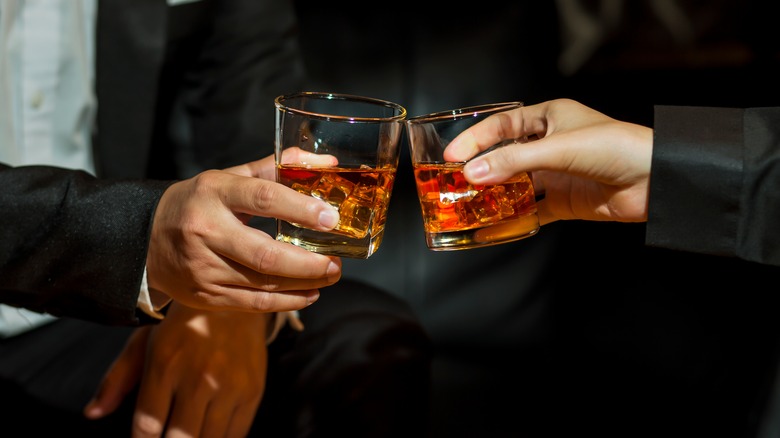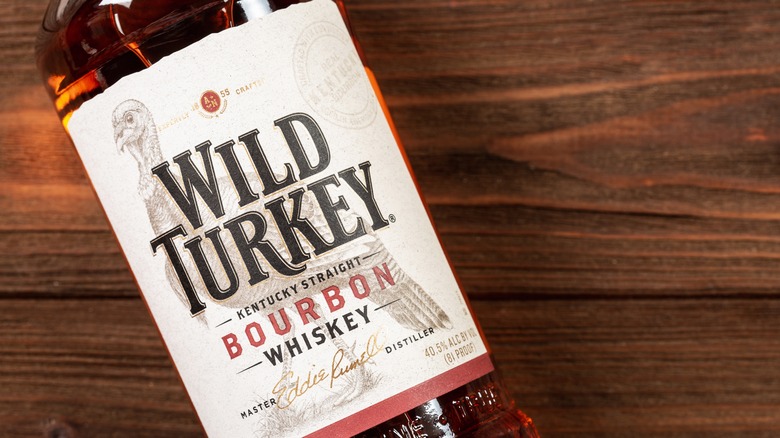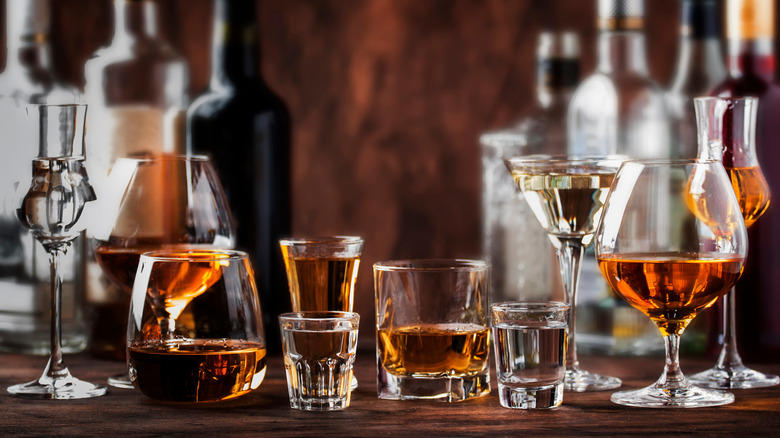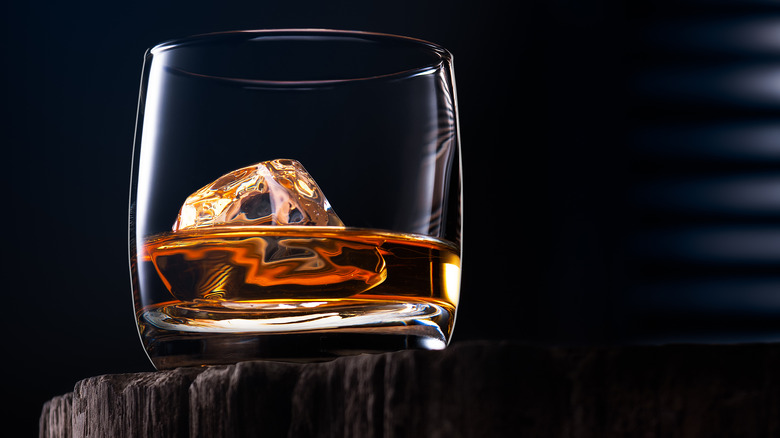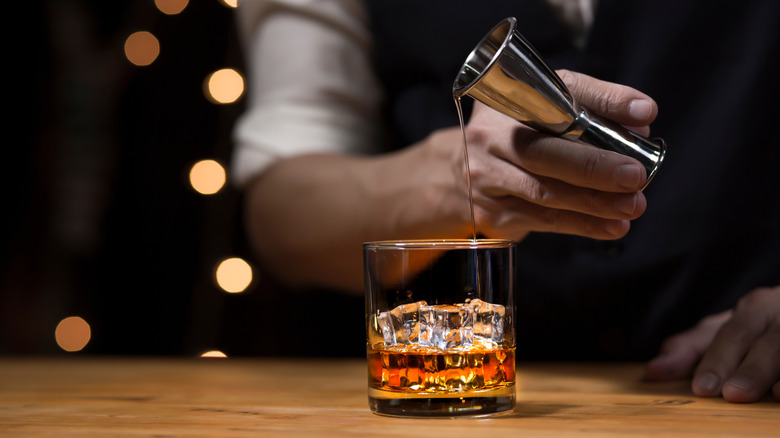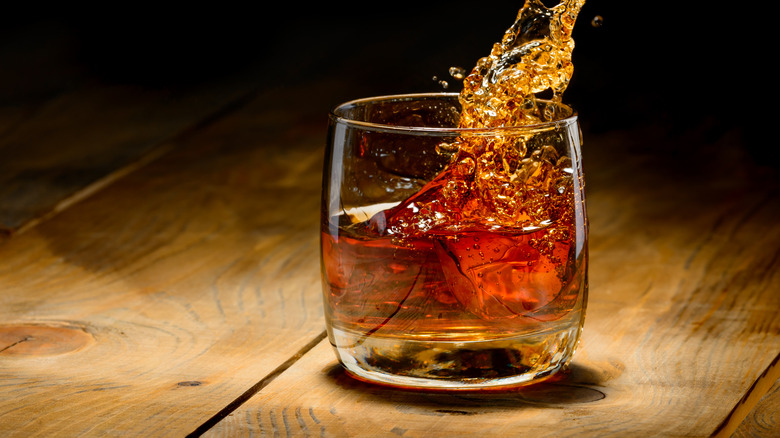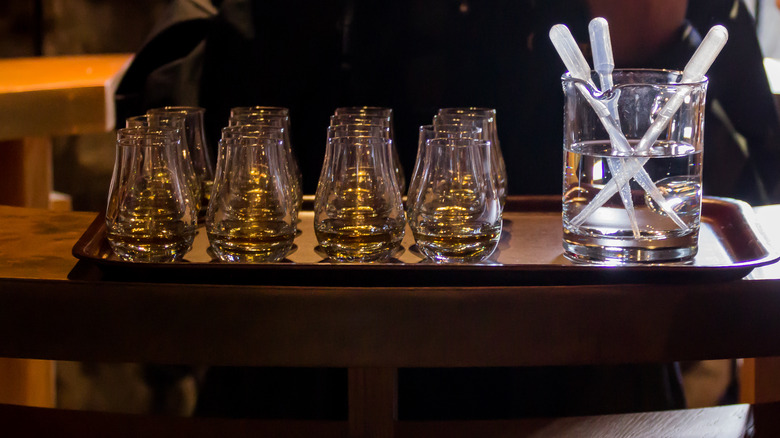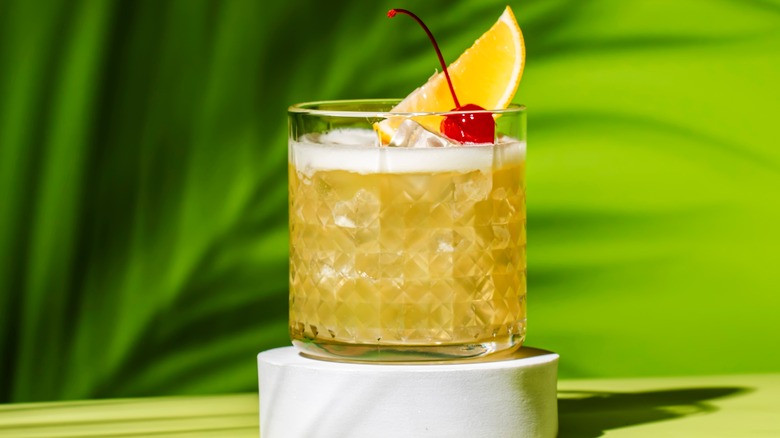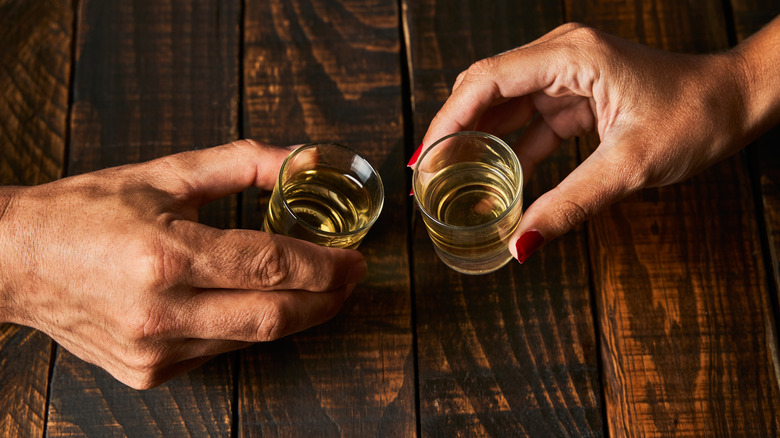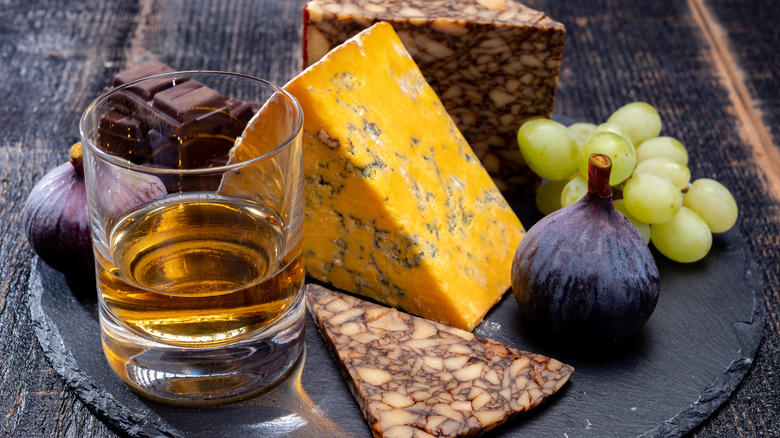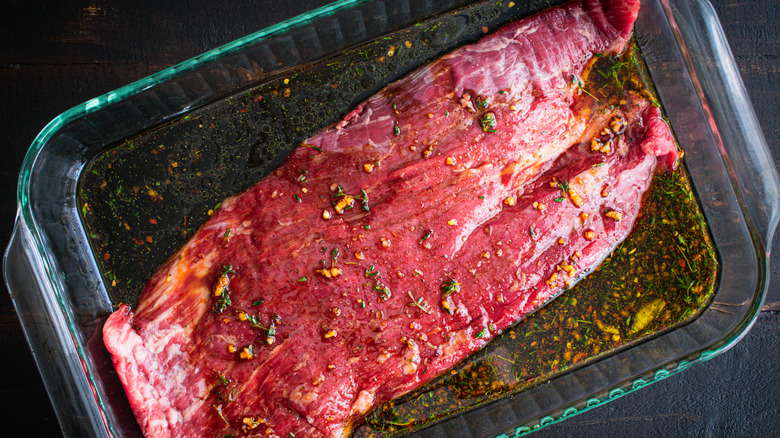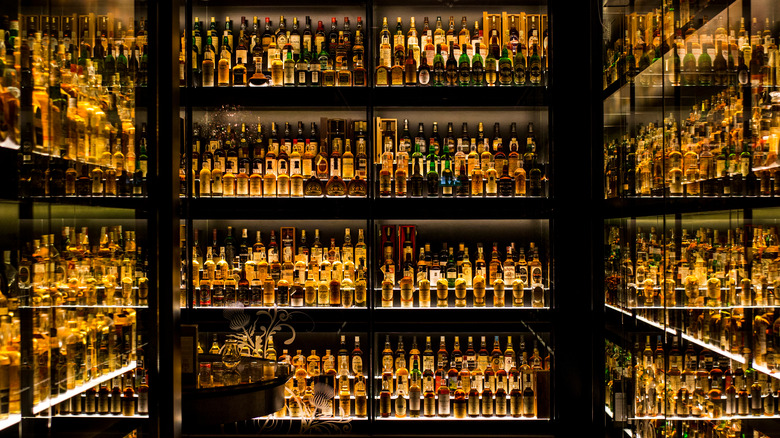Mistakes Everyone Makes When Drinking Bourbon
Bourbon is one of those liquors that can adapt to anyone's tastes and preferences. According to the American Bourbon Association, bourbon offers a unique drinking experience due to its bold flavors and the strict specifications required to make it. Bourbon must have no additives present and must be made with at least 51% corn to give it more of a distinctive flavor compared to whiskey or scotch. To be considered straight bourbon whiskey, it also must be aged for at least two years in new charred oak barrels to bring out that signature flavor that bourbon drinkers know and love.
Some elements of bourbon can seem daunting to inexperienced drinkers, from evaluating the different types of bourbon to understanding the various nuances. Between bottled-in-bond, rye, blended, Kentucky, and even corn bourbon, choosing your ideal sipping bourbon can ultimately lead to either picking an overhyped, top-shelf option or a dust-covered, bottom-shelf mystery liquid.
Even after taking the plunge and buying a bottle of bourbon, some people tend to make mistakes when drinking it, such as masking the wonderful flavors with heavy syrup or taking shots like it's Jack Daniels. Bourbon can be a wonderful and contemplative liquor that can be enhanced with a few small changes to your drinking ritual.
Not reading the label
Everything starts with choosing the right bourbon — but that doesn't mean you should pick a bottle based on the most aesthetically pleasing label or the most interesting name. Reading and understanding a bourbon label can tell you more about the classification, age statement, and cask strength, allowing you to pick a variety that best suits your drinking needs, whether it's sipping or mixing (via Distiller).
Usually, the first thing that catches the eye is the name of the distillery where the bourbon comes from, like Woodford Reserve, Buffalo Trace, Blanton's, or Knob Creek. Under or above the distillery name, you'll likely find the bourbon classification, like single barrel, (American) single malt, bottle-in-bond, blended malt, and straight bourbon. Each bourbon classification is based on specifications for how it's made, like a single barrel that is bottled from one 53-gallon barrel or a malt bourbon made with barley.
Some labels also say "small batch" or "handcrafted" — these traits aren't based on any legal requirements and are determined by each brand. Some bourbons don't include an age statement, but for those that do, this indicates approximately how long it's been aged. This is different from the vintage date (which indicates when the bourbon was distilled) and the bottling date, per Distiller. There are dozens of other subtleties within bourbon labels that can hint at flavor profiles and uses, but understanding the basics makes for educated drinking.
Choosing the wrong bourbon glass
Bourbon is an interactive experience that requires swirling, swishing, and sipping that's similar to drinking wine. Picking the right bourbon glass, like picking the right wine glass, extracts different tastes and aromas that you could miss out on with the wrong glass. However, there isn't necessarily a right glass, just a plethora of options that are suited for different uses.
The most well-known and common glass is probably the rocks glass, also called the lowball or old fashioned glass (via World Whisky Day). Its wide rim may not be great for picking up nuanced smells, but it's perfect for muddling bourbon-based cocktails, like an old fashioned, and for drinking bourbon over ice. The highball glass is suited more for bourbon-based cocktails, like bourbon mixed with soda, cola, or ginger ale.
Glasses such as a snifter have a larger bowl that's perfect for swirling, but can release ethanol vapors that can mute the bourbon's aromas. However, the preferred tasting glasses are the tulip-shaped and narrow-rimmed Glencairn glass and the NEAT whiskey glass –– a bowl-shaped glass with a flared rim that was accidentally designed to be the perfect tasting glass, according to World Whisky Day. Whatever glass you choose, though, it's better than a red Solo cup, shot glass, or coffee mug (unless it's a hot toddy).
Choosing the wrong ice cubes
Drinking bourbon without ice, or neat, is a nice way to enjoy the liquor in its most natural state. However, pouring bourbon over ice can be an easier and more enjoyable way of drinking it, with more dilution and less burn. That said, the type of ice used is crucial for a balanced drink. Cocktails like a mint julep, whiskey sour, or bourbon and soda typically use crushed ice or ice cubes, while drinking straight bourbon over ice cubes may make the drink colder faster, but will also dilute it faster.
Bourbon is one of the liquors that benefits from slow cooling and slow dilution to prevent a watered-down drink. Whiskey cubes and spheres are perfect for even cooling and slower dilution — and they fit perfectly in a rocks glass, making for an enjoyable drink that stays colder longer (via Cleveland Whiskey). Whiskey stones are reusable and keep the drink cold without diluting it. However, they can be more expensive than the alternative, and the mineral-style stone can leave an odd aftertaste that interferes with the bourbon.
For making perfectly clear whiskey cubes and spheres, The Whiskey Wash recommends using filtered or distilled water to remove unwanted particles and boiling the water before putting it into the silicone molds. This makes the ice freeze faster and keeps it crystal-clear, perfect for any budget or bougie bourbon.
Not using a jigger to measure the whiskey
Making a balanced drink starts with the right amount of liquor. As a bartender, nothing is worse than pouring liquor straight out of the bottle and into a cocktail or tasting glass. Different cocktails and various ways to drink bourbon require a different amount of alcohol, and adequate measuring ensures an even sip every time.
You don't have to be a bartender or have fancy mixology tools to make a great drink. Jiggers or measuring glasses are great tools that are usually marked with foolproof measurements, while speed pourers are the fast, effective option — as long as you know how to properly pour with it. Even a shot glass works in a pinch as a cost-effective and overlooked bar tool in everyone's liquor cabinet.
For flights, you don't want to pour full shots, since tastings should be a marathon and not a sprint. You want about a ½ ounce (half a shot glass) — or roughly one finger's width — worth of bourbon for the right amount of liquid to form an opinion (via Distiller). For single-liquor cocktails like a mint julep or an old fashioned, 2 ounces (two shot glasses) worth of liquor is preferred, but adding different liquors to a cocktail decreases that amount. When drinking bourbon neat or on the rocks, 1-½ to 2 ounces of bourbon is best suited for a stiff enough drink that is able to be swirled comfortably (via Taster's Club).
Not letting the bourbon aerate
Aerating doesn't have to be for wine alone. Aerating bourbon isn't just another pretentious way to drink liquor, but is a scientifically proven way of unveiling flavors while mellowing out its harshness or burn. Not to mention, it can also improve the flavor of inexpensive or blended bourbons for those high-dollar taste buds on a budget (via Tim Loves Wine).
Paul Hughes, an assistant professor from Oregon State University, told Mashed how letting bourbon breathe after it's poured intensifies its flavors. Hughes explains that once the ABV (alcohol by volume) is higher than 17%, the "alcohol molecules tend to clump together in clusters," and that letting it aerate releases those molecules from the clusters to "open up the whiskey to reveal more flavors." In a Drinkhacker taste test, the results showed that aerating bourbon, even for as little as five minutes, allowed it to become more subtle over time and with deeper aromas on the nose, but the change wasn't as dramatic as with aerating wine.
For those really wanting to dive into new flavors, electronic spirit aerators do exist, but they are not necessary. In a pinch, normal wine aerators work just fine, as well as the traditional pouring and swirling method (via Tim Loves Wine).
Not adding water
To add water or not to add water can be a controversial debate in the bourbon world. On one hand, it's supposed to open it up for a smoother experience, but it can over-dilute the bourbon if done incorrectly. However, it's not just personal preference that determines the benefits of diluting bourbon –– scientific research backs it up.
In 2017, Björn Karlsson wrote about the molecular perspective of why we dilute whiskey, which was published in Scientific Reports. The taste of bourbon whiskey is actually determined by molecules, such as guaiacol, which contributes to its distinct smoky and vanilla flavors. These molecules have both water-repelling and water-attracting characteristics, and the guaiacol molecules bind to the alcohol molecules. The study showed that when the whiskey contained more than 59% ABV (alcohol by volume), the guaiacol molecules moved away from the liquid's surface, making the flavors less pronounced. However, when you add water, the guaiacol molecules cluster and concentrate at the surface, similar to how oil and water separate on contact, and improve the bourbon's taste.
Even with impressive research, it's hard to say how much water you should add to create the perfect balance. Some add just a few droplets using a bourbon water dropper, while others add ounces based on a formula to dilute the proof.
Combining bourbon with too many mixers
Bourbon is a no-frills liquor that doesn't need powerful, fruity syrups or fruit purees to taste good. In fact, masking the flavor of bourbon only hurts the cocktail, since there are so many natural notes that are missed out on. The perfect bourbon cocktail plays on its natural notes while adding flavors that complement them as opposed to hiding them.
A rule of thumb for making bourbon cocktails is that a little goes a long way — even a smidge of fresh lemon juice and simple syrup does wonders. One of the most well-known bourbon cocktails is the old fashioned –– a mixture of bourbon, simple syrup, bitters, and possibly muddled orange for added sweetness and citrus. Eater explored the elements of this classic cocktail and how it can be modernized in various ways by using unique bourbons, as well as different sweeteners like maple syrup, agave, and flavored bitters.
Things that other classic bourbon cocktails have in common are the pairing of sweet and sour — like the mint julep with mint and sugar or the Manhattan with Italian vermouth and bitters (via Esquire). Mixing with sodas like ginger ale and ginger beer creates a sweet and savory mixture that brings out the natural sweetness of bourbon. It's important to know when to shake, roll, and stir bourbon cocktails to avoid over-dilution –– you shake citrus juice and egg yolks, but you stir cocktails that are mostly spirits, and never shake anything carbonated.
Drinking bourbon like a shot
Bourbon is meant for sipping, not shooting. It's a delicate yet robust liquor that should be appreciated and not rushed, unlike its whiskey counterparts like Jack Daniels. Drinking bourbon is very similar to drinking wine, with the slightly overexaggerated tasting notes, swirling, smelling, and swishing. That said, taking your time and contemplating every sip can unlock some interesting and unexpected flavors.
The first important step is choosing the right tasting glass, like a Glencairn glass or a NEAT glass. After pouring and hopefully aerating, note the color –– according to The Scout Guide, darker bourbons tend to be more robust and aged than lighter bourbons. Next, swirl the bourbon, nose the glass, and smell with your lips slightly parted to get past the initial alcohol aroma.
Finally, sip the whiskey and hold it without swallowing — this is also called the Kentucky Chew — and examine the possible flavors like vanilla, oak, tobacco, peaches, herbs, and hundreds of other characteristics (via Bourbon Inspector). Repeat the process with small sips until you feel tipsy or like a professional whiskey sommelier.
Not pairing bourbon with your food
Pairing wine with food can feel like old hat, but pairing your food with bourbon is an intoxicatingly creative way to enhance flavor in both the spirit and the food. And it doesn't stop with the entree — bourbon can be paired with a wide variety of meats, cheese, cuisines, and even desserts.
Similar to mixing food and wine, it's important not to overwhelm the palate and to focus on pairing either complementary or contrasting flavors. Whisky Advocate suggests pairing bourbon with similarly sweet treats like a fruit tart or chocolate mousse, or with opposing bold flavors like Nashville-style fried chicken or bacon-wrapped sweet potatoes. It also recommends pairing bourbon and food based on texture and mouthfeel, such as the saltiness and creaminess of aged cheese, like Asiago and Parmesan, to bring out the citrus notes of bourbon (via Bourbon+).
Different types of bourbon pair differently as well, such as Kentucky straight bourbon favoring creamy appetizers and candied nuts, or high-rye bourbon that complements savory Southern foods like ribs and cornbread (via The Gentlemanual). Six- to 12-year-aged bourbons and light-rye bourbons favor the saltiness of nuts and bitterness of dark chocolate, while wheated bourbons neutralize and complement the creaminess of filled pastries, caramel, and fruit (via Bourbon+).
Using it only for drinking
Whoever said bourbon was just for drinking obviously doesn't drink while cooking. Not only does bourbon pair well with food, but it can also be a vital ingredient to spruce up any dessert, marinade, sauce, or other culinary creations. It goes especially well with sweet flavors such as brown sugar, mint, chocolate, apple, and pears, as well as savory foods like ham, pork, peaches, and sweet potatoes (via Fine Cooking).
A good rule of thumb when cooking with bourbon is that if it's not good to sip, it won't taste good in food. Don't use your top-shelf rare bourbon, but don't use the lowest of the bottom shelf either –– a good middle ground like Knob Creek or Four Roses will suffice. As with pairing bourbon, different styles will affect different foods and cooking times (via Liquor.com). Lower-proof bourbon requires less time for the alcohol to cook away, while the higher-proof counterpart coagulates meats and fats quicker.
Not only is bourbon a delicious way to deglaze a pan or add depth to a gravy or sauce, it also makes for a wonderfully smoky tenderizer, marinade, or base for a braise. However, don't forget to mix it into your favorite desserts like sorbet, cakes, and fruit tarts. Wheated bourbons tend to be sweeter, making them the ideal addition to jams and jellies, while peppery rye bourbons complement rich and creamy fruit-based desserts and dressings, per Liquor.com. Who says you can't have your cocktail and eat it, too?
Storing bourbon improperly
In addition to cooking with and sipping your new favorite bourbon, it's important to store it correctly so that it's ready for the next use. Not only does proper storage prolong the flavor of the bourbon, but it also protects your investment. Unlike wine, whiskey does not mature or spoil when unopened, and does not require fancy equipment or storage.
There are a few key things to keep in mind when it comes to correctly storing bourbon bottles. Store the bottle upright as opposed to on its side to preserve the cork, keep it out of direct sunlight, and keep it someplace that is temperature-controlled, like an air-conditioned closet or even a wine cellar (via E-Ville Spirits & Wines).
That said, storing open bottles of bourbon can be tricky. Bourbon will oxidize and dull in taste the longer it is open, so it's important to drink it within a few months of opening for peak flavor. To slow down the oxidation, you can decant the leftover bourbon into a small bottle to lessen the amount of air inside (via Whiskey Advocate). Most importantly, if it's gone bad, save yourself the emotional pain and pour it down the drain.
